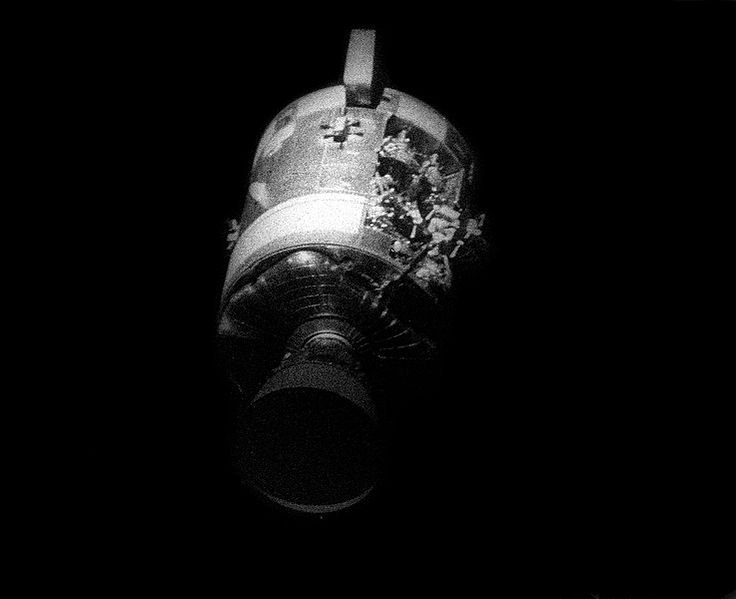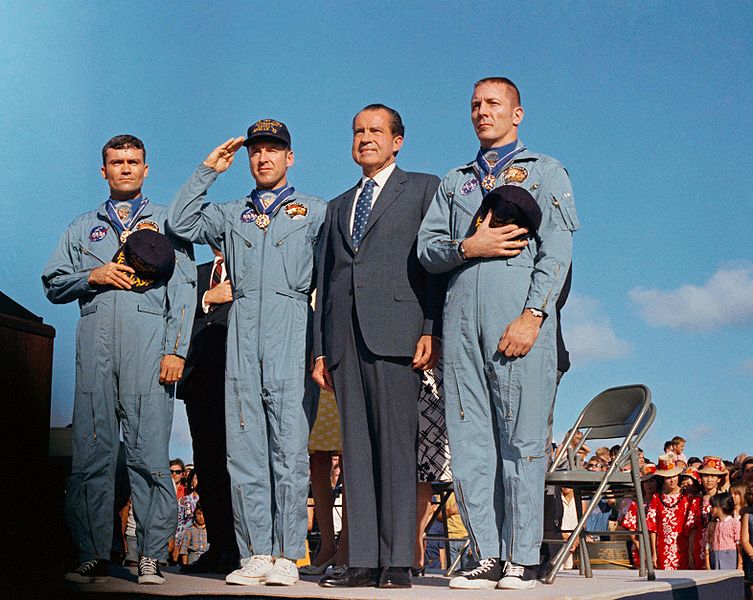Added 2 new A* pages:I said a little while back that I wanted to talk about the Apollo 13 mission a bit, and here's my chance!
Launching in 1970, Apollo 13 was going to be the third mission to land men on the Moon. But as their ship neared the moon, an electrical short-circuit in the Service Module--the module carrying the main engine and propellants--caused one of the oxygen tanks to explode. In addition to depleting a great deal of the mission's oxygen, it also left them without the use of the engines needed for landing on the Moon, and left the Command Module--the pod at the nose that houses the astronauts during Earth re-entry--on limited battery power.
So there's the three man crew, most of the way to the Moon, in a severely crippled ship! They had to evacuate into the Lunar Module--the thingy that lands on the Moon--and survived in there for four days while careful burns of the LM's engine looped them around the Moon and back toward Earth. Because they were on limited power, the temperature dropped down to somewhere in the 30's (I think--now I forget where I read this :P), drinking water was very limited, and they had to MacGuyver an air filter in order to be able to breathe.
But in the end, they made it back to Earth safely! Pretty incredible. A couple years later, NASA released a little documentary movie about it, named after the famous phrase used to report the explosion back to Earth, and now thanks to the magic of the Internet, you can view "Houston, We've Got A Problem" (actually the real phrase was the slightly less dramatic "had a problem," but hey) on archive.org.
When they were getting back to Earth, they released the crippled Service Module, so they could finally get a good look at the damage, and were surprised to see that the explosion had actually blown off some of the module's outer hull:

image by NASA (source)
Once they landed and got medals and stuff, President Nixon didn't miss a chance for a heroic photo op:

image by NASA (source)
The Wikipedia article (that top link) had a couple other notes about the mission that I found interesting. One of the astronauts developed a bad urinary tract infection during the mission because he wasn't getting enough water--that couldn't have made things easier. :o And speaking of urine, after the explosion, they were ordered to stop ejecting urine from the craft temporarily so as not to alter the ship's course, but they misunderstood, and stored all their urine for the rest of the entire flight. :p
And speaking of icky things, the mission's Lunar Module carried 3.8 kg (8.4 lbs) of plutonium-238 in what was called a SNAP--Systems for Nuclear Auxiliary Power; the plutonium's radioactive decay was going to be used to power a package of experiments to be left on the Moon (and five of them are on the Moon as we speak), but what with the accident and all, it unexpectedly came back to Earth! The Apollo 13 lunar module burned up in the Earth's atmosphere (as planned--the crew had moved into the Command Module for re-entry), and the SNAP fuel container, as it was designed to do, survived, its trajectory having been crafted so as to send it to a depth of 6,500 meters (20,000 feet) in the Tonga Trench in the South Pacific Ocean, where it appears to have settled, safely sealed. Whew! The fuel will remain significantly radioactive for about 2000 years, and its containment capsule is expected to hold up for 870 years. Hm. :P Well, there are lots of worse radiation risks we've dropped into various oceans over the years, particularly back in the swinging early days of the space program. Radioactive SNAPs are also on Mars, having powered the Viking landers, and winging toward the star Aldebaran and the constellation Aquila, aboard the probes Pioneer 10 and Pioneer 11, respectively, although their SNAPs are pretty low on power now (the craft were last heard from in 2003 and 1995), and will be completely decayed once the probes get near those other stars a few million years from now.
The Apollo 13 mission was dramatized of course in the 1995 Ron Howard film starring Tom Hanks, "Apollo 13," which...I haven't seen. Maybe I should check it out?
|
